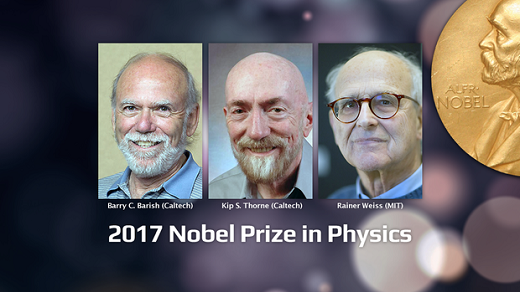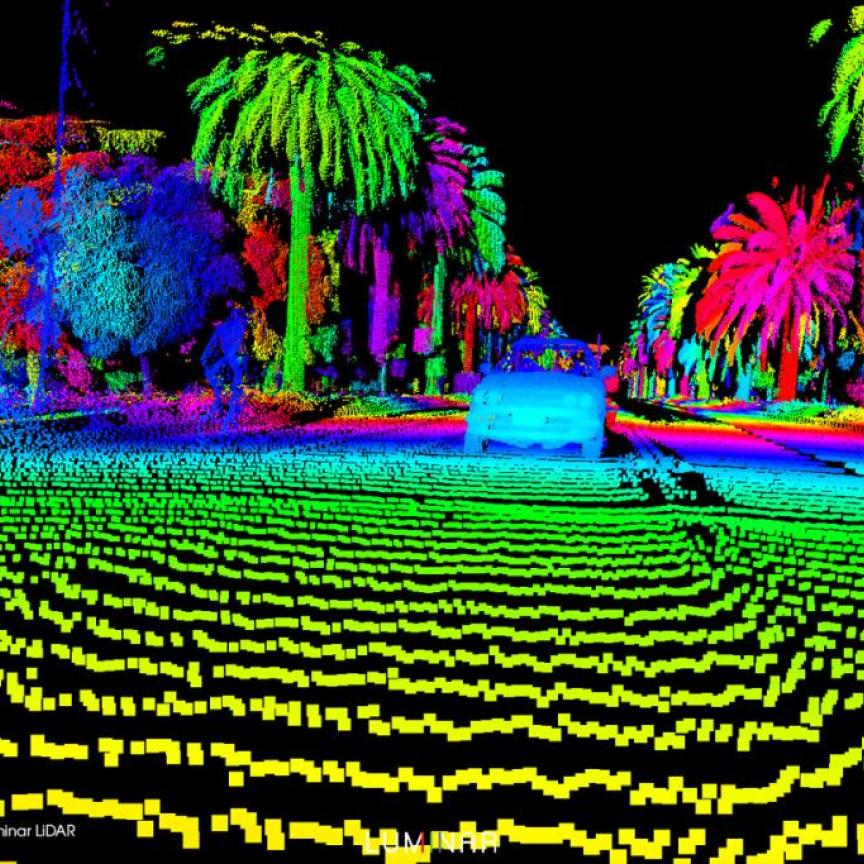Three scientists who made ‘decisive contributions’ to the detection of gravitational waves in 2015 have been awarded the 2017 Nobel Prize in Physics.

Credit: LIGO
Professors Kip Thorne, Barry Barish and Rainer Weiss were recognised by the Nobel committee for bringing to completion four decades of effort culminating in the observation of gravitational waves by the Laser Interferometer Gravitational-Wave Observatory (LIGO).
LIGO, operated by Caltech and MIT, is a collaborative project with input from more than 1,000 researchers from 20 countries. The observatory uses two huge laser interferometers to measure a change thousands of times smaller than an atomic nucleus.
On 14 September 2015, LIGO detected gravitational waves from the merger of two black holes, each around 30 times the mass of the sun. The event took place 1.3 billion years ago, producing a peak power output 50 times that of the entire visible universe. Einstein's general theory of relativity predicted such an event, but Einstein never believed that gravitational waves would be detected.
Since the first discovery, three more gravitational waves generated by two colliding black holes have been detected. The most recent of these detections, on 14 August 2017, was the first one using three detectors at the same time, namely the two Advanced LIGO detectors and the upgraded Advanced Virgo instrument in Italy, which jointly operated for four weeks starting 1 August 2017.
Speaking at a MIT press conference in response to the award, Rainer Weiss, professor of physics at MIT, said: 'I certainly feel humbled to be put in the same category as the giants of physics.' He added that the Nobel Prize is 'wonderful for everyone who has been working on this [gravitational wave detection]'.
Weiss noted during the press conference that the most recent gravitational wave detection by Virgo was the most interesting to date, as the team was able to pinpoint the source of the waves to only 60 square degrees, more than 10 times better than for the two LIGO interferometers alone. He added though that the real payoff of the work that won the Nobel Prize is going to be in the future.
History of LIGO
In the mid-1970s, Weiss had analysed possible sources of background noise that would disturb measurements, and had also designed a detector, a laser-based interferometer, which would overcome this noise. He published a paper titled: ‘Electromagnetically coupled broadband gravitational antenna’, where he described the design and promise of using laser interferometry to detect gravitational waves. The paper laid out the blueprint for LIGO, although at the time Weiss called it an antenna.
Weiss was recognised with half of the nine million Swedish krona prize, sharing the other half of the award with Kip Thorne, professor emeritus of theoretical physics at Caltech, and Barry Barish, professor emeritus of physics at Caltech.
Transforming LIGO from concept to reality would take another 20 years. In 1975, a meeting between Weiss and Thorne would set into motion the development of LIGO. Thorne convinced Caltech to create a gravitational-wave research group, led by Ron Drever from Glasgow University. Drever would go on to co-invent the Pound–Drever–Hall technique for laser stabilisation, which was critical to LIGO’s ability to detect gravitational waves. Sadly, Drever passed away earlier this year, but not before he learned of LIGO’s success.
In 1989, Weiss and Thorne, along with numerous others who were then working on the LIGO idea and gravitational wave physics, submitted a proposal for LIGO to the US National Science Foundation (NSF). The proposal included Weiss’s original design for the instrument, updated to include engineering and technology innovations that had occurred in the intervening 17 years. The NSF approved the proposal, and in 1994 construction began on the twin LIGO detectors in Hanford, Washington and Livingston, Louisiana.
Barish then joined the trio, becoming LIGO principal investigator in 1994, helping the growing cadre move from a small intensely focused group cooking up basic ideas to a large and broad team that could actually deliver the observatories and hardware.
Barish’s insights led not only to construction of the observatories and the initial detectors, but also to the creation of the LIGO Scientific Collaboration and to the successful proposal to build Advanced LIGO – the instrument that would finally make the first detection.
Many others worked on LIGO, and Professor Dr Karsten Danzmann, director of the Max Planck Institute for Gravitational Physics, paid tribute to Professor Dr Heinz Billing during a keynote speech at Photonics West in San Francisco earlier in the year. Billing, who died on 4 January 2017 aged 102, was one of a handful of scientists studying gravitational waves in the 1970s. 'He's the most modest scientist I've ever met,' Danzmann said.
The international collaboration also had input from scientists at the University of Birmingham, who developed the techniques to extract the properties of the sources from the gravitational wave signatures, and a team from the University of Cardiff, who developed large parts of the algorithm that was used to sift through the data in search of the key signal.
Future of gravitational wave astronomy
Plans for a third generation of gravitational wave detectors, like the Einstein telescope, are underway, while the Pathfinder mission for the Laser Interferometer Space Antenna (LISA) is currently testing the technology for a gravitational wave laser interferometer in space.
The importance of LISA is that it will cover a region of detection not possible with ground-based instruments.
The LISA Pathfinder mission was launched on 3 December 2015, one day after the 100th anniversary of the publication of the written version of Einstein's general theory of relativity. With a detector like LISA, the hope is that scientists will be able to detect the collisions of whole galaxies.
The LISA mission will consist of three satellites a million kilometres apart that form the three arms of a laser interferometer. At this kind of distance between satellites, a watt of laser power will be reduced to picowatts at the detector. LISA will be placed in a solar orbit 50 million kilometres behind the Earth and orbit the Sun like a rigid body while it passively listens to the universe.
The LISA Pathfinder mission is operating two test masses, with the distance between them reduced from a million kilometres to 35cm. At the heart of LISA Pathfinder are two free-flying gold cubes that travel inside the satellite. These gold cubes follow a purely geodesic curve, only influenced by gravity. The measuring capabilities between the two free-flying cubes is so sensitive that there would be a huge signal if a virus were to land on one of them.
Related article:
Gravitational-wave astronomy: opening a new window on the cosmos - Professor Martin Hendry from the University of Glasgow, whose team helped construct the LIGO facilities, discusses the work that preceded last year's discovery and what the future holds for the field of gravitational-wave astronomy

